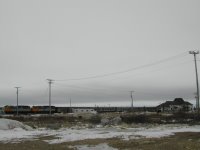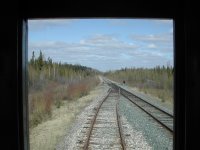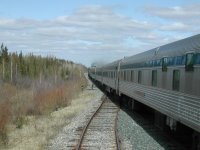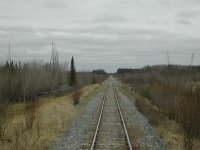
Shortly after we arrived this morning, our train reversed out of Churchill station, and was turned in a triangular turning circuit just outside town. It subsequently backed into the station, and was left there with engines running all day. From time to time I would round a corner and hear the not too distant hum of the gently throbbing locomotives. It might seem like a waste of diesel, but it’s safer than shutting down the engines and then discovering that they can’t be re-started. This especially important in the depths of winter, when a train failure could be extremely difficult to fix, and a replacement locomotive could take days to reach us. Despite their normally short consist, trains 693 and 692 to and from Churchill operate with two locomotives not for pulling power, but for safety. If one were to break down, there would not be much chance for another to reach a stranded train for some time. And in the depths of winter, if a train with a single locomotive was to break down, the heating in the passenger cars would soon drop far below freezing. It would cease to be a matter of convenience, and soon become a matter of life or death.
I’m early at the station (old habits die hard) but there is already a hub-bub on the station platform as luggage is loaded into the baggage car. The tourist office inside the old station building has a single VIA Rail ticket desk, and it’s from here that a locally employed agent sells tickets and provides information to passengers. I notice that on the desk is a pile of the new Amtrak system timetable. Perhaps a few other long distance journeys have commenced here?
Most of the tickets being sold, however, are for Thompson. There is a small group of young teenagers here this evening, all with violin cases and luggage for a couple of days away. I learn through overheard conversations that they are actually fiddles, not violins, and that they are presumably going to play in a concert or competition.
Of the handful of passengers who travelled north with me, two are returning to Winnipeg this evening as well. The two gentlemen, who I’d already met on the first night, had taken advantage of a VIA Rail special offer, which allows one passenger over the age of sixty to take a companion of any age for free. Both being over sixty, they paid one fare and split it between the two. Having lived in Winnipeg for much of their lives, they had decided (much like me) to take a trip to Churchill just for the sake of it. They had had a similarly interesting day, but had also retreated indoors in the afternoon to warm up.
Our train began boarding at about 20.15, preparing for a 20.30 departure. There was a healthy load of coach passengers, most going to Thompson and connecting to bus services from there. I boarded the sleeper car shortly afterwards.

Earlier today, Tara had mentioned that she would be making up another of the berths for another passenger. So when I re-board the train and head to the familiar couchette end of the carriage, I meet a new travelling companion. Vera has lived in Churchill since 1979, and she runs a three room bed and breakfast on Hearne Street (call 204-675-2544 for details). She has two sons in the town, and ever since she arrived here almost thirty years ago following a period in the Wrens, has called Churchill her home. One son works on a pilot boat that guides ships into the harbour. The other is an engineer in the Town Complex, and helps with the maintenance of the water supply. Tap water is sourced from the Churchill River, at a point about two miles inland from the town. Part of his job is to maintain the water heaters that heat the water three times between the river and the two. Without these (and the element heaters that many houses have in the pipes where the water enters the house) the pipes would freeze solid throughout the winter. Along with heavy duty engine block heaters that require cars to be plugged in overnight to prevent them from freezing up, it’s just another practicality in the life of the town.
It’s rewarding to finally talk to a Churchill resident for a short while. She says she is yet to be convinced that the port will ever be open for much longer, but says that despite the bitter winters she enjoys living here. Everyone knows everyone, and it’s a tight community. I ask about the inevitable flip side of remote life in Canada: are there drug or alcohol problems in Churchill? Her answer is yes – there will always be a few heavy drinkers, but the drug problem is harder to solve. A town meeting later this week will be bringing together the officers of the RCMP and local residents. Until specific information can be brought against members of the community suspected of supplying drugs (such as fatally addictive crystal meths) not much can be done.
We leave a few minutes early, and together we watch the settlement slip away. In ten or fifteen minutes, we cross the level crossing that had announced our arrival to me this morning, and we’re on our way back across the wilderness once more. Ten hours in Churchill might seem a short justification for eighty hours of travelling, but at this time of the year I didn’t miss much in town. Besides, for me the journey has been as much the destination as the town itself.
Shortly after leaving Churchill, Tara returns to make up the third pair of bunks. A passenger in coach class has decided to pay the night fare for a couchette through to Thompson, so we’ll be losing the spare pair of seats for the night. It’s fine with us – Vera goes forward to read in the coach car, and I decide to turn in early to read. For this half of the Churchill run, I’ve paid a bit more and booked a lower berth. Getting in and out of it is easier, and I get this time I get window. If there’s one complaint it’s that the lower bunk is just slightly too low: it’s not possible to lie in bed and look out of the window at anything other than the sky or the tops of the trees beside the track. But that’s hardly a major complaint. I curl up under the sheets, button the curtain closed and dive into
The Blind Assassin. Beside me, my picture window fills with an ever deepening blue, as the sun sets and night falls. I’m back in my natural habitat, it seems, warm and cozy, gently falling asleep to the sound of the train rattling over the tracks. It’s Tuesday evening: I will arrive in Toronto in three days time.
 I take a break from my book and my cheap dollar store su-doku puzzle book, and take a seat at the far end of the restaurant car to make myself a salami and cheese bagel for supper. At the other end of the car, the restaurant only serves three meals tonight. The economies of this train would give a private company a collective heart attack. But the joy of this journey is the reminder that passenger trains are not meant to turn an operating profit. Their benefit to communities and individuals cannot be measured, because they make otherwise impossible connections impossible, as well as providing employment to the people who operate the trains and the businesses that survive because of them.
I take a break from my book and my cheap dollar store su-doku puzzle book, and take a seat at the far end of the restaurant car to make myself a salami and cheese bagel for supper. At the other end of the car, the restaurant only serves three meals tonight. The economies of this train would give a private company a collective heart attack. But the joy of this journey is the reminder that passenger trains are not meant to turn an operating profit. Their benefit to communities and individuals cannot be measured, because they make otherwise impossible connections impossible, as well as providing employment to the people who operate the trains and the businesses that survive because of them. As we get further south, the landscape gets greener once again. I kid myself that I can feel the warmth of the sun through the window. North of Cormorant, we pass close by a lake, and the bright sun reflects along a sparkling line from the horizon to the edge of the lake next to the train. The sky is blue, and the water is bluer. At perfect moments like this, it’s only the strangest of sights that interrupt the view. We pass alongside a gravel road between us and the lake, and we catch sight of a hearse parked beside the road. The driver has stopped, and is getting out as we pass to take a photograph of our train.
As we get further south, the landscape gets greener once again. I kid myself that I can feel the warmth of the sun through the window. North of Cormorant, we pass close by a lake, and the bright sun reflects along a sparkling line from the horizon to the edge of the lake next to the train. The sky is blue, and the water is bluer. At perfect moments like this, it’s only the strangest of sights that interrupt the view. We pass alongside a gravel road between us and the lake, and we catch sight of a hearse parked beside the road. The driver has stopped, and is getting out as we pass to take a photograph of our train.














